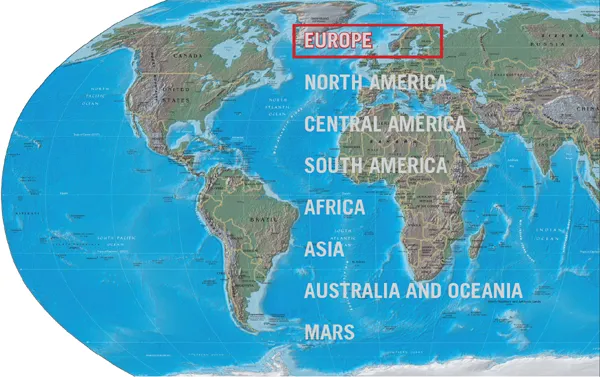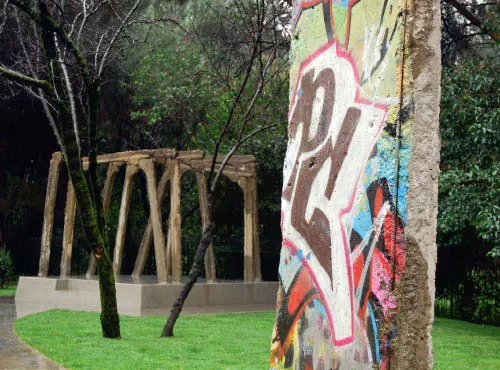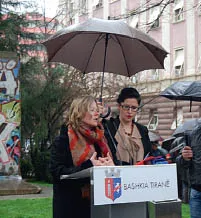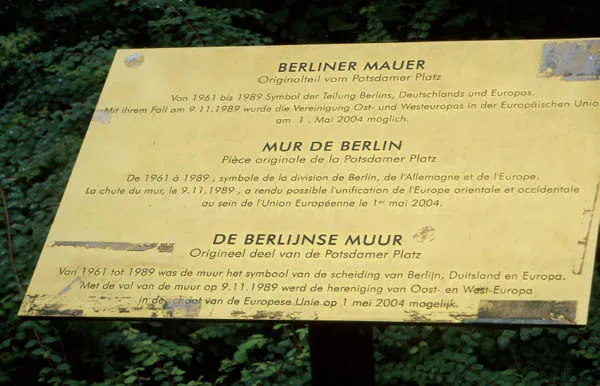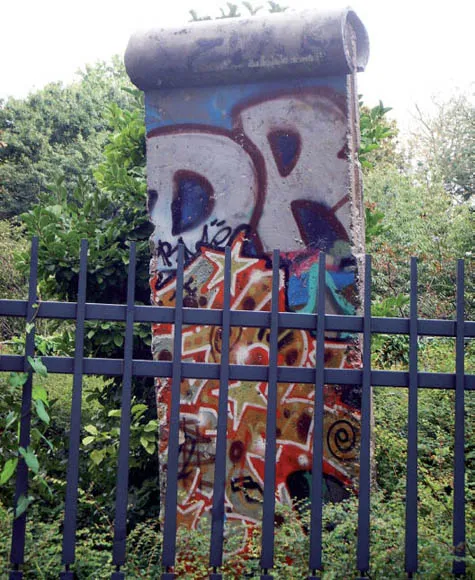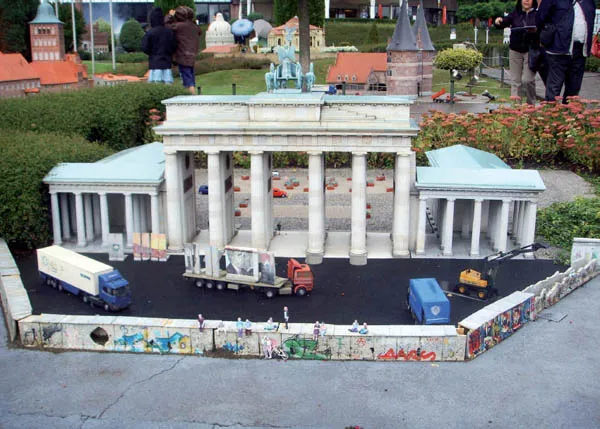![]()
TIRANA
ALBANIA
Location:
Martyrs of the Nation Boulevard
On 26th March 2013, a segment of the Berlin Wall was unveiled to a large crowd of joyous people. This section of the Wall was put up as a memorial to overcoming Enver Hoxha’s communist dictatorship. Albaninan Prime Minister, Sali Berisha, German ambassador, Carola Müller-Holtekemper and Mayor of Tirana Lulzim Basha all attended the unveiling. Anna Kaminsky, director of the Federal Foundation for the Reappraisal of the SED Dictatorship, who had been the driving force behind the project to get a piece of the Wall to Tirana, was also in attendance.
The Wall in Tirana
© Anna Kaminsky/Bundesstiftung Aufarbeitung
The section of Wall given to Tirana by Berlin – 3.6 metres-high and weighing 2.6 tonnes – makes up one part of three works which are collectively known as “Post-Bloc” – a collection of memorials. It was erected in the centre of of Tirana, which was once restricted under communist leadership, and is today an area known for its nightlife. The section of Wall, a present from the city of Berlin, makes up part of a memorial complex called “Post-Bloc”. It can be found in the former Soviet exclusion zone on “Martyrs of the Nation Boulevard”, which is today a popular entertainment area in the heart of Tirana. Alongside the Wall section are concrete columns from Spaçi labour camp as well as a bunker. This bunker is symbolic of the almost 750,000 bunkers scattered throughout Albania. The memorial was designed by Albanian writer Fatos Lubonja, who was imprisoned in work camps and solitary confinement for 19 years as a political prisoner and artist.The memorial was designed by Adrian Isuffi and remembers the victims of Enver Hoxha’s Communist dictatorship from 1945 until Hoxha’s death in 1985.
Anna Kaminsky at the ceremonious Wall unveiling
© Bundesstiftung Aufarbeitung
Political opponents, intellectuals, land owners, Muslim and Christian clergy and farmers against collective farming were all seen as being against the regime and were killed in scores of bloody purges or sentenced to long prison sentences or banished. The repression affected entire families, who were punished collectively. They were also banished or deported and forced into labour. Enver Hoxha’s repressive leadership style as well as the ever-present threat for Albanians from enemies, created an intimidated people filled with hate.
Albania’s political isolation lasted for over 40 years. It led not only to an extreme division of the country, but was a huge contributing factor to the impoverishment of the people. Ramiz Alia became the second and last Communist leader after Hoxha’s death in 1985. Despite making many economical reforms and making progress in international politics, he continued to lead according to Communist ideals. Protests, which began in late autumn 1990 and were mainly led by students, brought Ramiz Alia and his party into difficulties. In mid-December 1990, his party renounced its exclusive mandate. The formation of new political parties was permitted. The Social Democratic Party of Albania was formed in 1990 and was the direct successor of the Stalinist Communist party. The Democratic Party of Albani was formed in 1991. The Social Democrats won the first free elections in 1991. However, unrest in light of this result led to new elections being held less than a year later. Sali Berisha’s Democratic Party of Albani won this election with a two-thirds majority.
BRUSSELS
BELGIUM
Location:
European Parliament Parc Léopold, Brussels, Belgium
Information board on the Wall behind the European Parliament, Brussels
© Jens Schöne, Berlin
In 2001, considerations were being made in Berlin to display a segment of the Berlin Wall in Belgium. A section of the Wall had already been given to the European capital as a symbolic gesture from Berlin, but it remained in Germany. It was only after a suitable site was found that it was loaded onto a transporter on Potsdamer Platz and taken to Belgium.
The segment was presented to the public in Parc Léopold, Brussels, not far from the European Parliament on 22nd April 2004. It was presented to Michaele Schreyer (commissioner for the European Commission and former Senate of Berlin representative) on behalf of the German capital by André Schmitz (Senate Chancellery – Cultural Affairs). Michaele Schreyer had taken part in the memorable West Berlin senate assembly in Rathuas Schöneberg (Schöneberg city hall) on 10th November 1989. Representing Belgium at the ceremony were Jacques Simonet (Minister-President of the Brussels Capital-Region) and Jos Chabert.
The section of the Berlin Wall is visible from the European Parliament as well as from the Committee of Regions building. Delegates from over 300 local authorities and communities from allover Europe meet there to discuss European politics.
In view of the then forthcoming 2004 enlargement of the European Union, it should be made clear that the division of Europe was resolved. The segment was put up behind a fence and can only be only be viewed from outside. A small plaque commemorates the division of Germany and Europe in the three official languages of Belgium: German, French and Dutch.
Berliner Mauer
Originalteil vom Potsdamer Platz
Von 1961 bis 1989 Symbol der Teilung Berlins, Deutschlands und Europas. Mit ihrem Fall am 9.11.1989 wurde die Vereinigung Ost- und Westeuropas in der Europäischen Union am 1. Mai 2004 möglich.
Mur de Berlin
Pièce originale de la Potsdamer Platz
De 1961 á 1989, symbole de la division de Berlin, de l’Allemagne et de l’Europe. La chute du mur, le 9.11.1989, a rendu possible l’unification de l’Europe orientale et occidentale au sein de l’Union Européenne le 1er mai 2004
De Berlijnse Muur
Origineel deel van de Potsdamer Platz
Van 1961 tor 1989 was de muur het symbool van de scheiding van Berlin, Duitsland en Europa. Met de val van de muur op 9.11.1989 werd de hereniging van Oost- en West-Europa in de schoot van de Europese Unie op 1 mei 2004 mogelijk.
“The Berlin Wall
Original segment from Potsdamer Platz
From 1961-1989 symbol of the division of Berlin, Germany and Europe. With its fall on 9.11.1989, the unification East and West Europe in the European Union on 1st May 2004 was made possible.”
Information board on the Wall behind the European Parliament, Brussels
© Jens Schöne, Berlin
BRUSSELS
BELGIUM
Location:
Mini Europe, Bruparck
Miniature of the Wall in Bruparck, Brussels
© Jens Schöne, Berlin
The Brandenburg Gate can also be found in Brussels between the Holsten Gate and the Speyer Cathedral. The Berlin Wall runs in front of the gate – people walk alongside it and even sit on it – without hinderance from border soldiers. Low-loading trailers and demolition equipment can be seen on the other side. The dismantling and transportation of the former border fortifications is underway. The famous Wall graffiti, depicting Breschnew and Honecker and the famous Brotherhood Kiss (which was actually painted on a segment at the East Side Gallery), can also be seen.
These miniature replicas can all be seen in the Mini Europe Park at the foot of the world famous Atomium. The miniatures, which were financed by the European Union and the city of Brussels, have all b...

